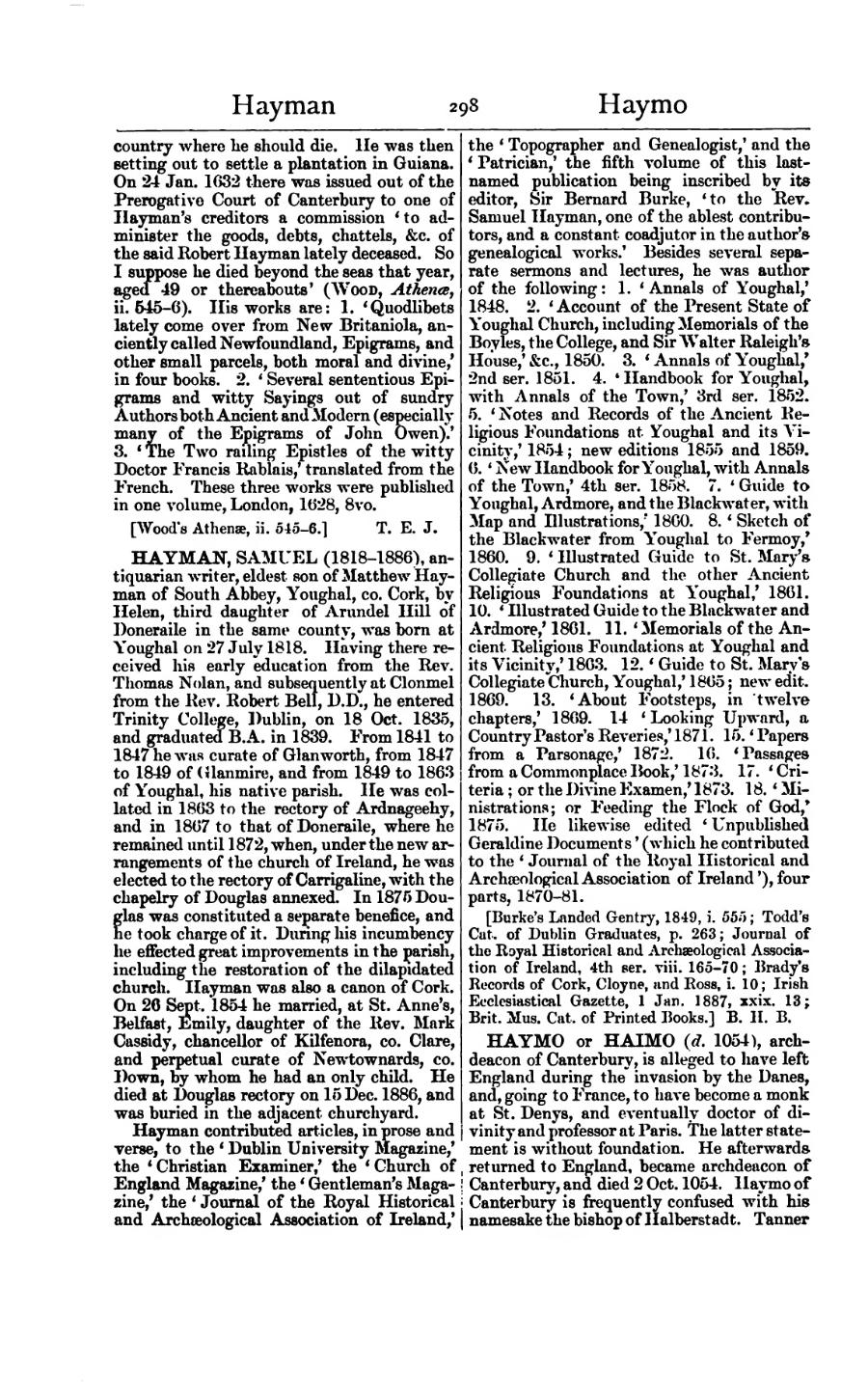country where he should die. He was then setting out to settle a plantation in Guiana. On 24 Jan. 1632 there was issued out of the Prerogative Court of Canterbury to one of Hayman's creditors a commission ‘to administer the goods, debts, chattels, &c. of the said Robert Hayman lately deceased. So I suppose he died beyond the seas that year, aged 49 or thereabouts’ (Wood, Athenæ, ii. 545–6). His works are: 1. ‘Quodlibets lately come over from New Britaniola, anciently called Newfoundland, Epigrams, and other small parcels, both moral and divine,’ in four books. 2. ‘Several sententious Epigrams and witty Sayings out of sundry Authors both Ancient and Modern (especially many of the Epigrams of John Owen).’ 3. ‘The Two railing Epistles of the witty Doctor Francis Rablais,’ translated from the French. These three works were published in one volume, London, 1628, 8vo.
[Wood's Athenæ, ii. 545–6; Notes and Queries, 10th ser. x. 23–4 (by Prof. Moore-Smith).]
HAYMAN, SAMUEL (1818–1886), antiquarian writer, eldest son of Matthew Hayman of South Abbey, Youghal, co. Cork, by Helen, third daughter of Arundel Hill of Doneraile in the same county, was born at Youghal on 27 July 1818. Having there received his early education from the Rev. Thomas Nolan, and subsequently at Clonmel from the Rev. Robert Bell, D.D., he entered Trinity College, Dublin, on 18 Oct. 1835, and graduated B.A. in 1839. From 1841 to 1847 he was curate of Glanworth, from 1847 to 1849 of Glanmire, and from 1849 to 1863 of Youghal, his native parish. He was collated in 1863 to the rectory of Ardnageehy, and in 1867 to that of Doneraile, where he remained until 1872, when, under the new arrangements of the church of Ireland, he was elected to the rectory of Carrigaline, with the chapelry of Douglas annexed. In 1875 Douglas was constituted a separate benefice, and he took charge of it. During his incumbency he effected great improvements in the parish, including the restoration of the dilapidated church. Hayman was also a canon of Cork. On 26 Sept. 1854 he married, at St. Anne's, Belfast, Emily, daughter of the Rev. Mark Cassidy, chancellor of Kilfenora, co. Clare, and perpetual curate of Newtownards, co. Down, by whom he had an only child. He died at Douglas rectory on 15 Dec. 1886, and was buried in the adjacent churchyard. Hayman contributed articles, in prose and verse, to the ‘Dublin University Magazine,’ the ‘Christian Examiner,’ the ‘Church of England Magazine,’ the ‘Gentleman's Magazine,’ the ‘Journal of the Royal Historical and Archæological Association of Ireland,’ the ‘Topographer and Genealogist,’ and the ‘Patrician,’ the fifth volume of this last-named publication being inscribed by its editor, Sir Bernard Burke, ‘to the Rev. Samuel Hayman, one of the ablest contributors, and a constant coadjutor in the author's genealogical works.’ Besides several separate sermons and lectures, he was author of the following: 1. ‘Annals of Youghal,’ 1848. 2. ‘Account of the Present State of Youghal Church, including Memorials of the Boyles, the College, and Sir Walter Raleigh's House,’ &c., 1850. 3. ‘Annals of Youghal,’ 2nd ser. 1851. 4. ‘Handbook for Youghal, with Annals of the Town,’ 3rd ser. 1852. 5. ‘Notes and Records of the Ancient Religious Foundations at Youghal and its Vicinity,’ 1854; new editions 1855 and 1859. 6. ‘New Handbook for Youghal, with Annals of the Town,’ 4th ser. 1858. 7. ‘Guide to Youghal, Ardmore, and the Blackwater, with Map and Illustrations,’ 1860. 8. ‘Sketch of the Blackwater from Youghal to Fermoy,’ 1860. 9. ‘Illustrated Guide to St. Mary's Collegiate Church and the other Ancient Religious Foundations at Youghal,’ 1861. 10. ‘Illustrated Guide to the Blackwater and Ardmore,’ 1861. 11. ‘Memorials of the Ancient Religious Foundations at Youghal and its Vicinity,’ 1863. 12. ‘Guide to St. Mary's Collegiate Church, Youghal,’ 1865; new edit. 1869. 13. ‘About Footsteps, in twelve chapters,’ 1869. 14. ‘Looking Upward, a Country Pastor's Reveries,’ 1871. 15. ‘Papers from a Parsonage,’ 1872. 16. ‘Passages from a Commonplace Book,’ 1873. 17. ‘Criteria; or the Divine Examen,’ 1873. 18. ‘Ministrations; or Feeding the Flock of God,’ 1875. He likewise edited ‘Unpublished Geraldine Documents’ (which he contributed to the ‘Journal of the Royal Historical and Archæological Association of Ireland’), four parts, 1870–81.
[Burke's Landed Gentry, 1849, i. 555; Todd's Cat. of Dublin Graduates, p. 263; Journal of the Royal Historical and Archæological Association of Ireland, 4th ser. viii. 165–70; Brady's Records of Cork, Cloyne, and Ross, i. 10; Irish Ecclesiastical Gazette, 1 Jan. 1887, xxix. 13; Brit. Mus. Cat. of Printed Books.]
HAYMO or HAIMO (d. 1054), archdeacon of Canterbury, is alleged to have left England during the invasion by the Danes, and, going to France, to have become a monk at St. Denys, and eventually doctor of divinity and professor at Paris. The latter statement is without foundation. He afterwards returned to England, became archdeacon of Canterbury, and died 2 Oct. 1054. Haymo of Canterbury is frequently confused with his namesake the bishop of Halberstadt. Tanner

